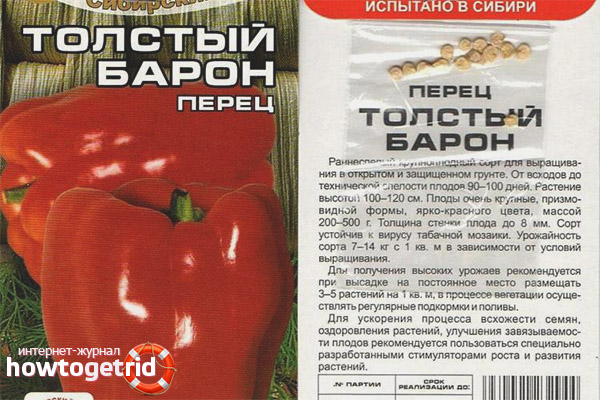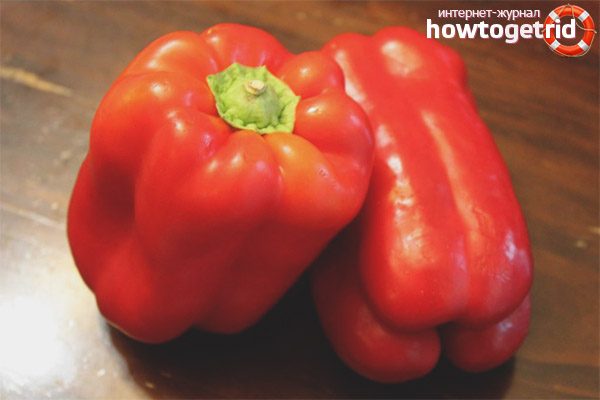The content of the article
The variety of bell pepper Fat Baron is characterized by a high dry matter content, fleshiness and balanced carbohydrate content. Fruits are large spherical in shape, walls up to 1.5 cm, in the seed chambers a small amount of seeds. Seeds can be harvested for sowing in subsequent years.
Grade description
This variety is perfect for workpieces, it makes a delicious lecho. In the stage of biological ripeness, the fruits turn red. The thick baron is ideal for decorating dishes and freezing.
Another feature is the high content of carotene in the pulp, which is a powerful antioxidant. Brightly colored fragrant fruits are very popular with children.
How to grow pepper at home
Growing pepper is easy. You only need to take care of the purchase of planting material in advance. Buy seeds only in specialized stores, from trusted suppliers.
Grains should be checked for germination, then soaked for swelling for a day. Soil is recommended to use purchased. If you decide to prepare the soil mixture yourself, add river sand, a handful of ash and humus to it.
Germination of seeds occurs 7-8 days after sowing at a temperature of 20-22 degrees. At a lower temperature, the seeds will germinate 2-3 days longer. You can cover the sown seeds with glass or film to create a microclimate in an impromptu greenhouse.
It is best to grow seedlings on the windowsill of the south side. Beginning gardeners are often in a hurry to plant seeds as early as possible in the hope of getting an early harvest. This is one of the common mistakes. The fact is that young plants are in dire need of solar energy. When sowing pepper seeds in January-February, the seedlings will simply not have enough light, the plants will turn out to be frail, yellow, unviable.
If you still decide to sow pepper in February, take care of additional lighting. The backlight should be carried out for two hours in the morning and in the evening.
Seedling Care
The first top dressing is performed 2 weeks after emergence. Use a weak solution of urea or ammonium nitrate to feed. Nitrogen fertilizers stimulate the growth of green mass of the plant.
Young seedlings are watered very carefully, first from the sprayer. Pepper does not tolerate drafts.
Do not overdo it with watering. With excess moisture, the roots can rot.
When 3-4 true leaflets appear, peel the plants in separate containers. Do not neglect this procedure, it stimulates the growth of the root system.
Transplanting peppers into pots, dig plants into the soil using cotyledon leaves. If the plants are not planted, but left to grow in one container, they will soon begin to compete for light, water and nutrients. Such seedlings will never develop into a strong plant, it will not bring a good harvest, it will hurt and take root for a very long time.
Pepper care in open ground and greenhouses
Seedlings are planted at the age of 35 days. On plants, the presence of buds is allowed. Seedlings should not be overgrown, elongated, yellow.
Add humus to the planting holes, pour plenty of warm water over the soil.
Pepper takes root long enough after transplanting, the fact is that its roots grow slowly, not at all like, for example, the roots of tomatoes.
After planting in soil or a greenhouse, young plants are watered, and if necessary, they are shaded from the scorching rays of the sun.
An important procedure in the care of the culture is the mulching of the aisles. A layer of mulch protects the top layer of fertile soil from moisture evaporation.
Pepper loves chernozem, rich soils, responds well to the application of organic fertilizers.
During flowering, it is recommended to increase the number of waterings. At the stage of buds laying, fruit formation, potash and phosphate fertilizers are added.
The pepper ripens in waves, in 3-3 waves. Harvesting is recommended at the stage of technical ripeness. Fruit clipping stimulates the formation of new flower buds, thereby increasing yield.
Variety Fat Baron is very productive. With proper care, you can collect from the bush up to 4 kg of fruit.
Video: growing pepper from A to Z











Submit